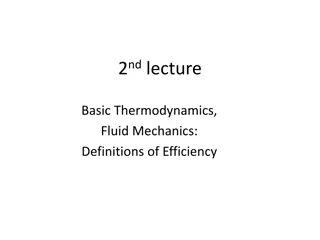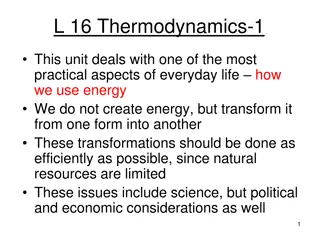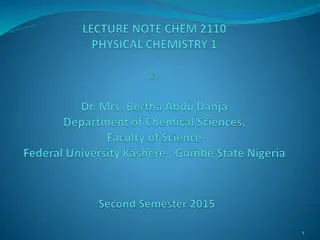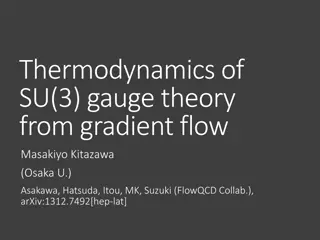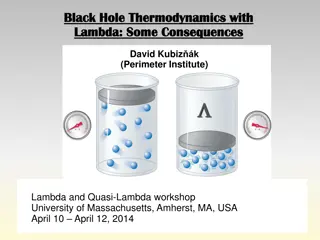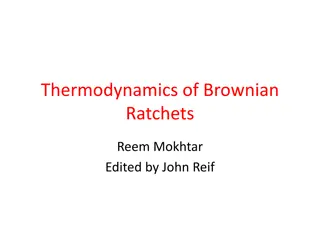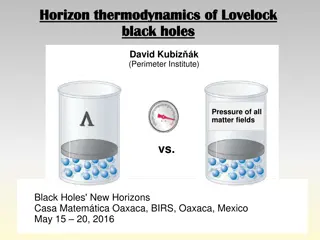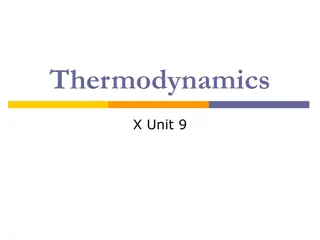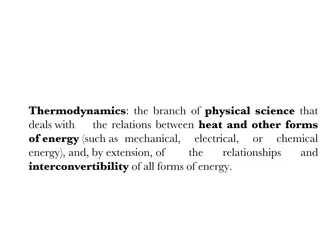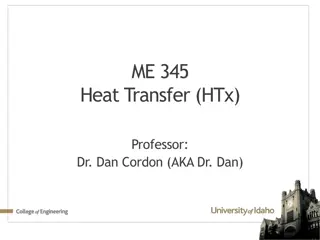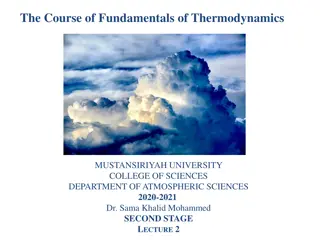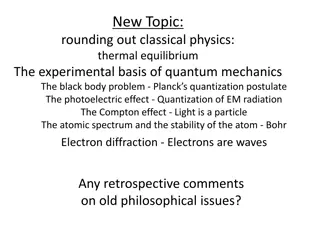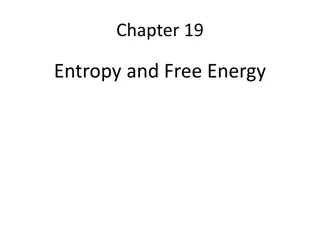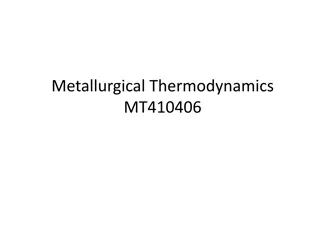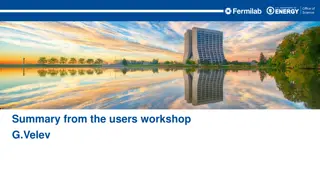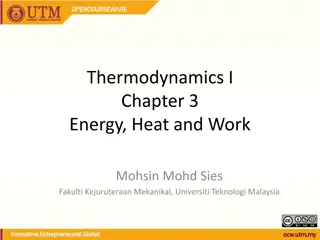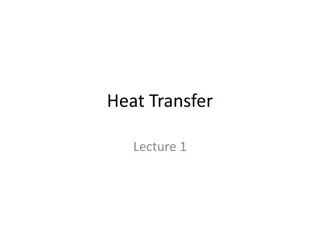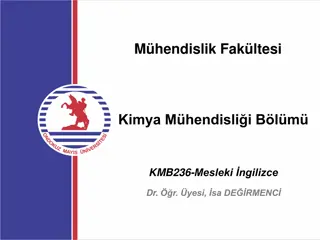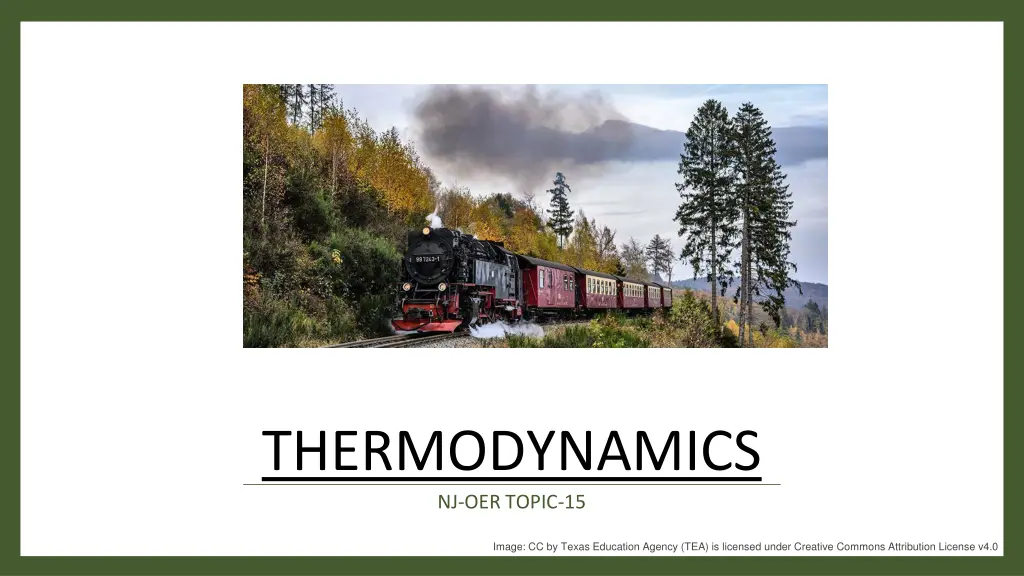
Understanding Thermodynamics: States, Processes, and Energy Changes
Learn about the properties of different thermodynamic processes such as isothermal and adiabatic, and how to calculate efficiency in heat cycles. Understand the concepts of internal energy, heat, work, specific heat, and entropy in relation to thermodynamics principles.
Download Presentation

Please find below an Image/Link to download the presentation.
The content on the website is provided AS IS for your information and personal use only. It may not be sold, licensed, or shared on other websites without obtaining consent from the author. If you encounter any issues during the download, it is possible that the publisher has removed the file from their server.
You are allowed to download the files provided on this website for personal or commercial use, subject to the condition that they are used lawfully. All files are the property of their respective owners.
The content on the website is provided AS IS for your information and personal use only. It may not be sold, licensed, or shared on other websites without obtaining consent from the author.
E N D
Presentation Transcript
THERMODYNAMICS NJ-OER TOPIC-15 Image: CC by Texas Education Agency (TEA) is licensed under Creative Commons Attribution License v4.0
Original Publication Year 2022 General Physics I by Moe Tabanli is licensed under aCreative Commons Attribution-NonCommercial-ShareAlike 4.0 International License, except where otherwise noted. To learn more about the Open Textbook Collaborative, visit https://middlesexcc.libguides.com/OTCProject Under this license, any user of this textbook or the textbook contents herein must provide proper attribution as follows: If you redistribute this textbook in a digital or print format (including but not limited to PDF and HTML), then you must retain this attribution statement on your licensing page. If you redistribute part of this textbook, then you must include citation information including the link to the original document and original license on your licensing page. If you use this textbook as a bibliographic reference, please include the link to this work https://opennj.net//physics- tabanli in your citation. For questions regarding this licensing, please contact library@middlesexcc.edu Funding Statement This material was funded by the Fund for the Improvement of Postsecondary Education (FIPSE) of the U.S. Department of Education for the Open Textbooks Pilot grant awarded to Middlesex College (Edison, NJ) for the Open Textbook Collaborative. Open Textbook Collaborative The Open Textbook Collaborative. (OTC) project is a statewide project managed by Middlesex College along with assistance from Brookdale Community College, Ocean County College , Passaic County Community College, and Rowan University . The project engages a consortium of New Jersey community colleges and Rowan University to develop open educational resources (OER) in career and technical education STEM courses. The coursesalign tocareer pathways in New Jersey s growth industries including health services, technology, energy, and global manufacturing and supply chain management as identified by the New Jersey Council of Community Colleges.
Differentiate states from processes Relate change of internal energy to heat given to the system and work done by the system Identify properties of isothermal, adiabatic, isobaric and isovolumic(isochoric) processes Complete a P V T table of states Complete a U Q W table for processes and cycles Draw and interpret a PV diagram for a process Apply conservation of energy to heat cycles Calculate efficiency of different heat cycles including Carnot cycle Learning Outcomes
U=Internal Energy Q = Heat Q is positive when heat is given to the system Q is negative when heat is exhausted W= Work done by the system W is positive when work is done by the system W is negative when work is done to the system Cp= specific heat at constant pressure Cv= specific heat at constant volume e=efficiency S=Entropy Concepts
SI UNITS Heat, internal energy and work done are in Joules Efficiency and Entropy are dimensionless Units
U= 3/2 ??? =3/2 nRT monatomic gas ?? = 3/2 n R ?T monatomic gas ?? = ? + Won (First Law of Thermodynamics) or ?? = ? WBy Wby = - Area under PV graph Formulas and Constants SPECIAL CASES Wby= P V (only for ???????? ???????) ?? = 0 (only for isothermal process) ? = 0 (only for ???volumetric ???????) Q =0 (only for adiabatic process) ?? = 0 (For all cycles)
KEY STRATEGIES Label the states with A,B,C,D index Label processes with AB, BC, CD, DA index If any of the P,V,T values are not given, estimate them using the ideal gas law Write the zeroes of the processes using the properties of isothermal, adiabatic, isovolumic processes Using U=Q-W find the unknowns for each process deltaU = 0 for a cycle For a heat engine, identify Qin, Qout, Wnet and find efficiency
CLASSWORK FOR U Q W TABLE Process U Q W An ideal gas goes through a cycle with 4 process starting from a state "A" A->B is an isothermal expansion and 30J work is done B->C is an isobaric contraction where internal energy is decreased by 25J and 40J of heat is exhausted. (deltaU=-25 , deltaQ=-40) C->D is adiabatic where internal energy is increased by 20J D->A is isovolumic where 5J heat is given to the system isothermal 0 adiabatic 0 isovolumic 0 U = Q - W Complete the U Q W Table and find the missing values. Verify that this is a cycle by adding change of internal energy. Identify Qin, Qout and Wnet. Consider the zeroes of the table on the right. Efficiency is Qin/Wnet PROCESS U Q W A->B isothermal 30 B->C isobaric -25 -40 C->D adiabatic 20 D->A isochoric 5 TOTAL FOR THE CYCLE: 0 |Qin|-|Qout| Wnet
TYPICAL PV GRAPHS FOR PROCESSES / CYCLES Images: CC by Texas Education Agency (TEA) is licensed under Creative Commons Attribution License v4.0
ACTIVITY Open https://www.geogebra.org/m/KAZHEN8c Start your cycle (Point 1) at P1=40 kPa and V1= 1m3 Construct the following 4 step cycles and complete an approximate PVT table using the values that you measure from the graph A) Isothermal expansion, isovolumic pressure drop, isochoric compression, isobaric back to Point 1 B) Otto cycle (adiabatic, isochoric, adiabatic, isochoric) C) Diesel cycle (Isobaric, adiabatic, isochoric, adiabatic) D) Carnot cycle (isothermal, adiabatic, isothermal, adiabatic) E) Come up with your own cycle You have to move the points closer in the beginning and adjust them so that the cycle is complete without the need of a fifth process.
CLASSWORK FOR PV GRAPH Draw an approximate PV graph for each of the following process. Make sure you indicate the direction using an arrow Q1) Isobaric expansion at 30kPa pressure from 2m3volume to 3m3volume Q2) An ideal gas is heated in a locked piston with 4m3volume. As a result, its pressure is increased from 40 kPa to 60kPa Q3) A diatomic ideal gas goes through an adiabatic expansion from 20.0 kPa pressure and 1.0 m3 volume to 1.5 m3volume. (gamma=1.4 Pf=11.3 kPa) Q4) The pressure of a gas is increased from 25 kPa to 50kPa isothermally. (Use Vi Vf on the graph) Q5) The pressure of an ideal gas is increased linearly from 15 kPa to 30 kPa during the process its volume increased from 3.2 m3to 4.8m3
PV DIAGRAM FOR CARNOT CYCLE Heat entered to the system Qh and, heat exhausted from the system Qc can be shown in PV diagram For all cycles e= 1-[Qc/Qh] e= W/Qh Qh-Qc=W For Carnot Cycle only e=1-[Tc/Th] Image:: Reversible Carnot Circle in p-V-Diagram by MikeRun is licensed under the Creative Commons Attribution-Share Alike 4.0 International License
CLASSWORK FOR THE SECOND LAW OF THERMODYNAMICS AND EFFICIENCY Q1) During a heat cycle 40J of work is done and 30J of heat is exhausted. Find the efficiency Q2) A carnot engine operates at a hot temperature of 500 Kelvin and a cold Temperature of 350 Kelvin. Find the efficiency. Find the work done if the Qhot=6000J Q3) We want to build the following cycle First the gas expands adiabatically and doing 20J of work Later the gas expands isobarically doing 20J of work using 30J of heat In the third phase 10J of heat given isovolumically Finally the system is brought back to the original state isothermally with W=-25J Complete the table Find Qhot Find Qcold Find W Find the efficiency C->D PROCESS FOR Q3 U Q W A->B B->C D->A
CLASSWORK FOR ENTROPY Q1) 4 kg Ice melts. Find the change in its Entropy Q2) In the morning 0.050 kg air vapor condensates to dew. Find the change in Entropy Q=+m L or Q=-mL Lf=334,000 Lv=2,260,000 Q3) Calculate the change in Entropy for an isothermal expansion of a 30 moles of monatomic ideas gas at 40,000 Pascal pressure when it expands from 3 m^3 volume to 6 m^3 of volume. Find the temperature first using PV=nRT. Find the Workdone using W=nRT ln (Vf/Vi). Find the heat given to the system using U=Q-W. Using Q and T, find the entropy. HINTS: For Q1 there are two processes. For Q2, although there are two objects, there are three processes. Melted ice must be heated up too. For Q3-Q4 there are 4 processes.
REFERENCES Slide 1-8: Open Stax College Physics online textbook Slide 9: Screenshot from Ophysics and Geogebra by Tom Walsh using P-V Diagram and Work Author: Dave Nero Slide 11: MikeRun, CC BY-SA 4.0, via Wikimedia Commons

